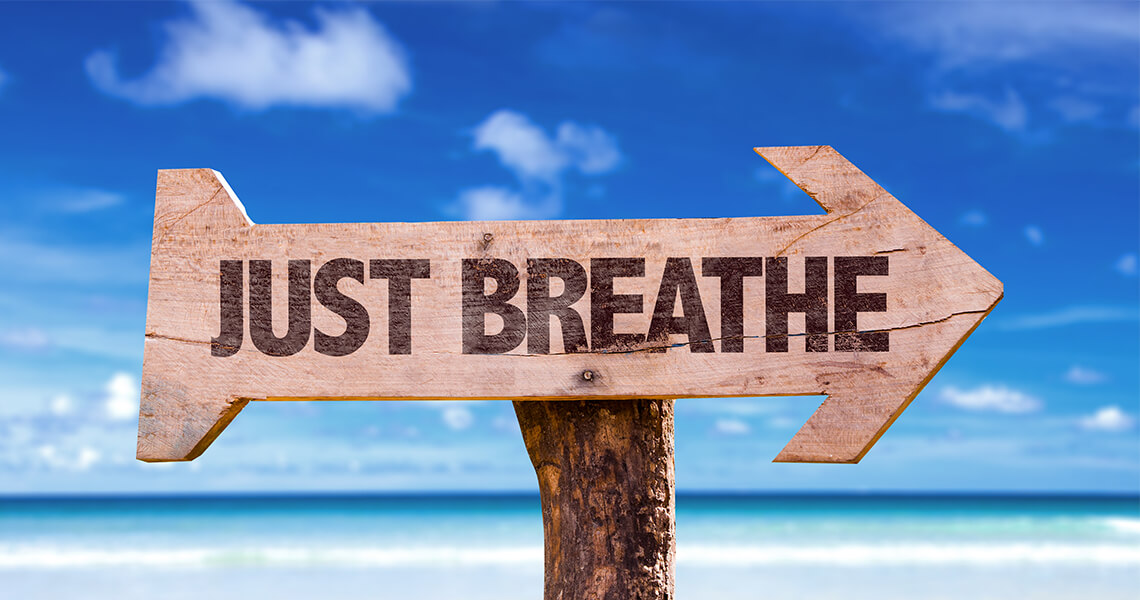‘Just breathe!’ – Breathing your way to better health.
Breathing is the only vital function under both voluntary and involuntary control. We can be distracted, dosing or even unconscious, and our breathing is taken care of. By contrast, we can direct our attention to our breath, and purposefully alter our breathing pattern. This ability of our breath to straddle both our conscious and unconscious experience is in large part thanks to the diaphragm, situated just below our lungs, which comprises both smooth and skeletal muscle.
One consequence of breathing cutting across the mind-body divide is that we can become caught up in positive and negative feedback loops. Because the physiology and psychology of breathing are inextricably intertwined, breathing patterns vary according to our emotional state, just as our emotional state varies according to our breathing patterns.
For example, you have an exam to sit and are feeling incredibly anxious about it, believing it will be too difficult for you. This anxious belief sets off a chain reaction in the body, affecting your breathing pattern, biochemistry, and physiological responses. These, in turn, create bodily symptoms, leading to a second tier of anxiety, further affecting your breathing. By now, you are anxious about your breathing and your body symptoms as well as the exam, and locked into a self-perpetuating cycle.
The good news is that we can modulate and even reverse this chain reaction by engaging our breath as an ally to calm things down, rather than ramp things up.
At this stage, it is useful to clarify some key terms. Breathing is the physical process by which you inhale oxygen from the atmosphere and exhale carbon dioxide from the lungs back out into the atmosphere. This movement of gas in and out of the lungs is also known as ventilation. Respiration is an involuntary chemical process whereby the inhaled oxygen is used to break down glucose and to produce energy, carbon dioxide and water.
When we inhale, our lungs expand, our diaphragm and intercostal muscles contract, and internal air pressure decreases to facilitate the intake of oxygen. Breathing in also gently activates the SNS (sympathetic nervous system) to aid this increase in effort.
When we exhale, our diaphragm and intercostal muscles relax, and internal air pressure increases to expel CO2. Breathing out gently activates the PNS (parasympathetic nervous system) to release this effort and relax.
Balanced, healthy breathing is highly adaptive, suited to the circumstances and the body’s changing metabolic needs. For example, in pregnancy a woman breathes more shallowly, but at a faster rate to compensate for decreased lung capacity. Conversely, a fit soldier tabbing with 25kg on his back breathes deeply, inhaling and exhaling large amounts of oxygen and CO2 respectively.
However, when the breath does not match physiological needs, often for psychological or emotional reasons, it creates imbalance, as with our exam anxiety example above. This can be termed dysfunctional breathing.
Think of a breathing continuum ranging from shallow, under-breathing know as ‘hypoventilation’ to rapid over-breathing, termed ‘hyperventilation’. Either end of the spectrum carries unpleasant symptoms, and in extreme and chronic cases has health implications. Chronic hypoventilation can lead to high levels of CO2 and acid in the blood, or ‘acidosis’. Chronic hyperventilation can lead to low levels of CO2 and high levels of alkaline in the blood, or ‘alkalosis’. Symptoms are unpleasant and include muscle spasms, weakness, confusion and numbness. An acute bout of hyperventilation in the absence of real danger can be synonymous with a rapid escalation of anxiety and panic attacks. Chronic dysfunctional breathing can compromise our immune system.
Thus, the importance of balanced breathing and respiration is not only key to sustaining life, but has a ripple effect on our physical, mental and emotional health and wellbeing.
Yoga, Mindfulness and a host of bodywork therapies have long understood this, and have the breath as a central pillar of their practices. Effective therapies for trauma, such as EMDR, Somatic Experiencing, Sensorimotor Psychotherapy and TRE® (Tension & Trauma Release Exercises) all pay attention to the breath.
Our breath patterns literally create physiological states that create perceptions about how safe, unsafe, friendly or hostile the world is. Learning and practising an array of conscious breathing techniques helps balance us physiologically, psychologically, emotionally and spiritually. Watch out for my follow-up article containing some practical examples of different breathing practices to promote health and wellbeing.
